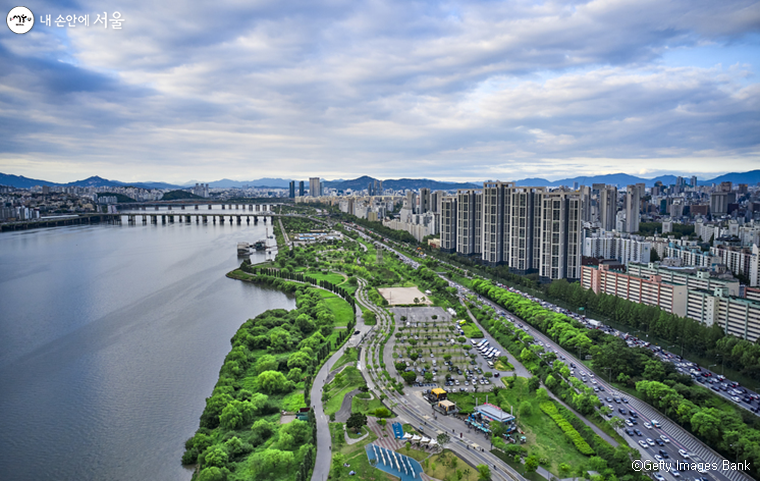상세 컨텐츠
본문

'한반도'는 남한과 북한 모두를 이르는 말인데, 나라의 반 이상이 바다에 둘러 쌓여 있고 일부는 육지에 연결되어 있어서 '한국'을 의미하는 한자 '한(韓)'과 '반도(半島)'를 합쳐서 '한반도'라고도 부르기도 합니다.
'한반도' is a term that refers to both South Korea and North Korea, as more than half of the country is surrounded by the sea, and one side is connected to the land. Therefore, it is sometimes called 'Korean Peninsula' by combining the Chinese characters for 'Korea(韓; 한)' and 'Peninsula(半島; 반도)'.

많은 한국 사람들은 한반도의 모양이 호랑이를 닮았다고 믿습니다. 과거에 한국을 침략했던 나라들은 한반도가 토끼의 옆 모습을 닮았다고도 했습니다만, 아마 반도 국가의 특성상 한국이 오래 전부터 다른 나라의 침략을 받아 왔기 때문에 약한 토끼보다는 침략하는 나라에 대한 용감한 호랑이로 그들의 정체성을 찾고자 한 것 같습니다.
Many Koreans believe that the shape of the Korean peninsula resembles that of a tiger. In the past, countries that invaded Korea also claimed that the peninsula resembled the profile of a rabbit. However, perhaps due to the nature of a peninsular nation that has long been subject to invasion by other countries, Koreans identified themselves with the brave tiger rather than a weak rabbit, in order to find their identity as a nation.

한편 실제로도 과거 한국의 산에는 호랑이가 많이 살았는데, 호랑이가 산에서 내려와 사람들을 헤치는 일이 많았기 때문에 한국의 속담과 설화에는 호랑이와 관련된 것들이 아주 많습니다. 심지어 한국의 건국 신화인 '단군 신화'에도 호랑이가 등장하고, 지금까지 한국에서 치른 올림픽 마스코트에도 호랑이가 두 번이나 등장했는데, 여기에서 한국인의 호랑이 사랑의 뿌리를 짐작할 수 있지요.
On the other hand, there were actually many tigers living in the mountains of Korea in the past, and since tigers often came down from the mountains and attacked people, there are many Korean proverbs and folktales related to tigers. Even the founding myth of Korea, the 'Dangun Myth(단군 신화),' features a tiger. Additionally, tigers have appeared twice as mascots in the Olympics held in Korea, and from this we can see the roots of the Koreans' love for tigers.

앞서 언급했듯이 한국의 대부분은 바다로 둘러싸여 있지요. 이 부분을 세 부분으로 나누어 동쪽 바다는 '동해', 서쪽 바다는 '서해', 남쪽 바다는 '남해'라고 부릅니다. 동해에는 오징어로 유명한 울릉도와 동쪽 끝 섬인 독도가 있고, 서해에는 인천국제공항이 위치한 영종도와 인삼으로 유명한 강화도가 있습니다. 그리고 남해에는 한국에서 가장 큰 섬인 제주도가 있는데, 제주도는 귤과 한라봉으로 유명합니다.
As mentioned earlier, most of Korea is surrounded by the sea. This area is divided into three parts, with the sea on the east side called the "East Sea(동해)," the sea on the west side called the "West Sea(서해)," and the sea on the south side called the "South Sea(남해)." Ulleungdo(울릉도), famous for squid, and Dokdo(독도), the easternmost island of Korea, are located in the East Sea. Yeongjong Island(영종도), where Incheon International Airport is located, and Ganghwa Island(강화도), famous for ginseng, are located in the West Sea. And Jeju Island(제주도), the largest island in Korea, is located in the South Sea and is famous for tangerines and Hallabong(한라봉) oranges.
또한 한반도는 국토의 70%가 산으로 이루어져 있습니다. 한반도에서 가장 높은 산은 북한에 있는 백두산(2,744미터)이고 두 번째로 높은 산은 제주도에 있는 한라산(1,940미터)입니다. 태백산맥은 한반도의 동쪽에 위치한 산맥으로, 말하자면 호랑이의 척추 같은 곳인데요, 이 산맥에 포함된 산 중에서 백두산, 금강산, 설악산이 경치가 아름답기로 유명합니다. 한반도의 동쪽에는 산이 많지만 남서쪽은 낮은 산과 평야가 많고 사이사이에 강도 많기 때문에 이 지역에서는 농사를 많이 짓습니다.
In addition, 70% of the Korean peninsula is made up of mountains. The highest mountain in the Korean peninsula is Mount Baekdu (2,744 meters), located in North Korea, and the second highest mountain is Mount Halla (1,940 meters) on Jeju Island. The Taebaek (range of)Mountains, located in the eastern part of the Korean peninsula, are like the spine of the tiger, and among the mountains included in this range, Mount Baekdu, Mount Kumgang, and Mount Seorak are famous for their beautiful scenery. While there are many mountains in the eastern part of the Korean peninsula, the southwest has many low mountains and plains with rivers in between, so farming is a common practice in this region.


한반도에서 중요한 강으로는 북한에 있는 압록강(790킬로미터)과 두만강(521킬로미터)이 있고, 남한의 낙동강(525킬로미터)과 한강(514킬로미터)이 있습니다.
In the Korean peninsula, there are important rivers such as the Amnok River (790 kilometers) and the Tumen River (521 kilometers) in North Korea, and the Nakdong River (525 kilometers) and the Han River (514 kilometers) in South Korea.

포스팅이 유익하셨나요?
Was the posting helpful for you?
이 포스팅을 작성할 때 사용한 자료는 아래에 있으니 더 자세한 정보는 아래를 참고해 주세요. 그리고 이 포스팅은 Teacher Joy가 학습자들을 위해서 작성한 창작물입니다. 따라서 이 포스팅을 퍼가거나 사용하실 때에는 반드시 출처 정보를 남겨 주세요.
The sources used to create this post are listed below for further information. And please note that this post is a creative work by Teacher Joy for learners. Therefore, if you share or use this post, please be sure to include the source information.
| < 참고 > - 중앙일보: 올림픽 마스코트부터 만병통치약까지... 호랑이의 해, 우리 문화속 호랑이는? https://www.joongang.co.kr/article/25037513#home - 울릉도에서 오징어로 할 수 있는 모든 것 '울릉도 오징어 축제' https://ncms.nculture.org/local-festival/story/89 - 산림청: 백두대간과 산맥체계 https://www.forest.go.kr/kfsweb/kfi/kfs/cms/cmsView.do?mn=NKFS_02_02_03_01_05&cmsId=FC_001108 - 헤드라인 뉴스: 금강산은 경치, 청량산, 지리산은 심신수양 https://www.iheadlinenews.co.kr/news/articleView.html?idxno=3661 - 오수연(2022). 범 내려온다!. 마케팅, 56(2), 52-58. - Cho, Han, Tcho(2017), Korean Culture in 100 Keywords, 62. - 나무 위키: 한반도 https://namu.wiki/w/%ED%95%9C%EB%B0%98%EB%8F%84 -울산 저널: 한반도 영토 상징 야생동물, 호랑이 http://m.usjournal.kr/news/newsview.php?ncode=1065574536127611 -https://educalingo.com/ko/dic-ko/hanbando |
'Knowledge > Readings on Korean' 카테고리의 다른 글
| The story of the Han River | 한강 이야기 (0) | 2023.05.31 |
|---|---|
| Educational system of Korea | 한국의 교육제도 (0) | 2023.04.27 |
| Foreign Community in Seoul | 서울의 외국인 마을 (0) | 2023.04.27 |
| Duty of Military Service of Korea | 한국의 병역 의무 (0) | 2023.03.25 |




댓글 영역